 Mount Huangshan
Mount Huangshan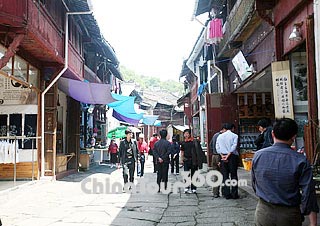 Tunxi Ancient Street
Tunxi Ancient Street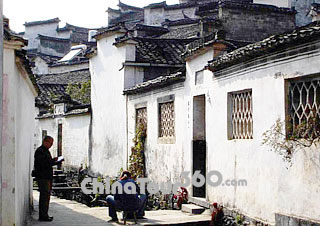 The Hui Style Architecture
The Hui Style Architecture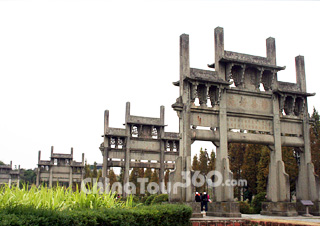 Tangyue Memorial Archway
Tangyue Memorial Archway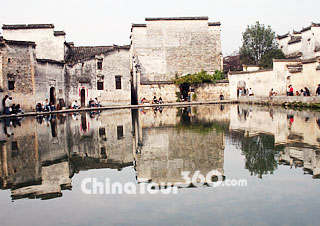 Hongcun Village
Hongcun Village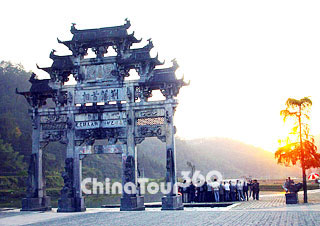 Xidi Village, Huangshan City
Xidi Village, Huangshan City
![]() Facts
Facts
Phone Code: 0559
Postal Code: 245000
Area: 3,786 square miles
Population: 1,359,000 (statistics in 2010)
Nationalities: Han, Hui, and She
Neighboring Areas: Henan, Hubei, Jiangxi, Zhejiang, Jiangsu and Shandong Province
Location: On the upper reaches of the Xin'an River, Huangshan is a prefecture-level city in the south of Anhui Province. The longitude lies between 117°-118.53°E and the latitude between 29.24°- 30.31°N.
![]() Physical Features: Huangshan city is mountainous with various geographic features. The landscape comprehends high and low mountain ranges, hills, basins and plains. Xin'an River, the principal river in the city, flows into the Qiantang River.
Physical Features: Huangshan city is mountainous with various geographic features. The landscape comprehends high and low mountain ranges, hills, basins and plains. Xin'an River, the principal river in the city, flows into the Qiantang River.
![]() History: From the late matriarchal society, Chinese forefathers had lived on this land. With the original name of Kuaiji County, it was administrated by the system of prefecture and county since the Qin Dynasty (221 - 206 BC). In Southern Dynasties (420 - 589 AD), it was renamed Xin'an County. Then, Xin'an was changed to Huizhou in 1121 AD in Song Dynasty. In 1987, it was changed to a regional-level city under Anhui Province's jurisdiction and got its name after the famous scenic Mt. Huangshan since it covers the vast expanse of the city.
History: From the late matriarchal society, Chinese forefathers had lived on this land. With the original name of Kuaiji County, it was administrated by the system of prefecture and county since the Qin Dynasty (221 - 206 BC). In Southern Dynasties (420 - 589 AD), it was renamed Xin'an County. Then, Xin'an was changed to Huizhou in 1121 AD in Song Dynasty. In 1987, it was changed to a regional-level city under Anhui Province's jurisdiction and got its name after the famous scenic Mt. Huangshan since it covers the vast expanse of the city.
 |
| Huangshan Maps |
![]() Attractions: With both geographical advantage and long history, the city has rich diversity of tourism resources, including high quality natural landscapes and places of cultural interest. Regarded as the most fantastic mountain on earth, Mt. Huangshan is well-known for its four wonders - fantastic pines, grotesque rocks, the sea of clouds and hot springs, and it was inscribed on the World Cultural and Natural Heritage List by UNESCO in 1990. Moreover, there are many other tourist sites in the city, such as Guniujiang Natural Reserve, Taiping Lake between Mt. Huangshan and Mt. Jiuhua, Tunxi Ancient Street, Xidi and Hongcun Ancient Villages, Huizhou Ancient Residential Houses and Tangyue Memorial Archways.
Attractions: With both geographical advantage and long history, the city has rich diversity of tourism resources, including high quality natural landscapes and places of cultural interest. Regarded as the most fantastic mountain on earth, Mt. Huangshan is well-known for its four wonders - fantastic pines, grotesque rocks, the sea of clouds and hot springs, and it was inscribed on the World Cultural and Natural Heritage List by UNESCO in 1990. Moreover, there are many other tourist sites in the city, such as Guniujiang Natural Reserve, Taiping Lake between Mt. Huangshan and Mt. Jiuhua, Tunxi Ancient Street, Xidi and Hongcun Ancient Villages, Huizhou Ancient Residential Houses and Tangyue Memorial Archways.
![]() Transportation: As a central travel city in the Yangtze Rive Delta, as well as the traffic hinge of East China, transportation in the city is convenient.
Transportation: As a central travel city in the Yangtze Rive Delta, as well as the traffic hinge of East China, transportation in the city is convenient.
![]() Air: Located in the Northwest of Tunxi District, Huangshan Airport is 3.4 miles from the city center. It has flights to Hong Kong, Shanghai, Beijing, Guangzhou, Hefei, Fuzhou, Shenzhen, Wuhan, and other destinations.
Air: Located in the Northwest of Tunxi District, Huangshan Airport is 3.4 miles from the city center. It has flights to Hong Kong, Shanghai, Beijing, Guangzhou, Hefei, Fuzhou, Shenzhen, Wuhan, and other destinations.
![]() Train: Beijing-Fuzhou High-speed Railway, Anhui-Jiangxi Double-track Railway and Huangshan-Hangzhou High-speed Railway join here. There are further plans to build railways from the city to Jinhua and Quzhou in Zhejiang province, Tongling-Taiping railway and an inter-city railway from Huangshan to Chizhou.
Train: Beijing-Fuzhou High-speed Railway, Anhui-Jiangxi Double-track Railway and Huangshan-Hangzhou High-speed Railway join here. There are further plans to build railways from the city to Jinhua and Quzhou in Zhejiang province, Tongling-Taiping railway and an inter-city railway from Huangshan to Chizhou.
- Huangshan - Shanghai
- Huangshan - Beijing
- Huangshan - Hangzhou
- Huangshan - Hefei
- Huangshan - Changsha
- Huangshan - Guangzhou
- Huangshan - Nanjing
- Huangshan - Suzhou
- Huangshan - Xiamen
- Huangshan - Yichun
- Huangshan - Xian
- Huangshan - Xuzhou
- Shanghai - Huangshan
- Beijing - Huangshan
- Huangshan - Shenzhen
- Hangzhou - Huangshan
- Hefei - Huangshan
- Changsha - Huangshan
- Nanjing - Huangshan
- Xian - Huangshan
![]() Bus: There are long-distance buses to Shanghai, Hangzhou, Nanjing, Hefei, Jiuhuashan, Jingdezhen, and other major cities in neighboring provinces. Round-Mt. Huangshan Road is now under construction. Visitors can take buses from Huangshan City Bus Station to the Mt. Huangshan Scenic Spot directly. In addition, there are 18 public bus lines in urban City.
Bus: There are long-distance buses to Shanghai, Hangzhou, Nanjing, Hefei, Jiuhuashan, Jingdezhen, and other major cities in neighboring provinces. Round-Mt. Huangshan Road is now under construction. Visitors can take buses from Huangshan City Bus Station to the Mt. Huangshan Scenic Spot directly. In addition, there are 18 public bus lines in urban City.
![]() Taxi: Taking a taxi in the city is convenient and cheap, about CNY5 for the first 3 km (1.9 miles) and CNY1.5 per km more for the left journey.
Taxi: Taking a taxi in the city is convenient and cheap, about CNY5 for the first 3 km (1.9 miles) and CNY1.5 per km more for the left journey.
![]() Weather: Located in the north subtropical zone, it has a climate features generally temperate with clear-cut four seasons, no intense cold in winter. Rain comes mainly from May to August. The scenery of this city is different from seasons, attracting tourists all year round.
Weather: Located in the north subtropical zone, it has a climate features generally temperate with clear-cut four seasons, no intense cold in winter. Rain comes mainly from May to August. The scenery of this city is different from seasons, attracting tourists all year round.
![]() Dining and Shopping
Dining and Shopping
Hui cuisine, one of the Eight Major Cuisines of China, originated in Shexian County. Visitors must on no account miss the chance to try some representative dishes, such as Chou Guiyu (Mandarin Fish), Shi'er Dunji (Stewed Shi'er and Chicken), and Huizhou Mao Tofu (Huizhou Odorous Bean Curd). Besides, local snacks like Xieke Huang (Yellow Crab Shell), La Ba Tofu (Dry Tofu Strips), Heluo (Stir-fried Pond Snail) are also delicious.
The best shopping place for travelers in the city is Tunxi Ancient Street. There are stores built during the Ming and Qing Dynasties, most of which deal with the elegant art wares, local products and tourist souvenirs. For tea favorites, they can learn Chinese tea culture and purchase high quality teas in Huangshan Tea City. In addition, there is a Jiadeli Supermarket on Huangshan East Road near to Tunxi Ancient Street, where various local snacks are sold in packages.
![]() Special Local Products: Huangshan Tea is famous both at home and abroad, including Keemun Black Tea, Tunxi Green Tea, Mao Feng Green Tea, Taiping Houkui and Dinggudafang teas. There are many other local specialties in the city, such as mushrooms (oyster mushroom, thick mushroom, forest mushroom), bamboo shoots, fiddlehead fern, Huizhou Gongju (a chrysanthemum tea), Huizhou Pear, Santan loquat, Kiwi fruit, orange in Shexian County and Xiangbang (formal name 'Torreya grandis' - a dry mountain fruit) in Yixian County.
Special Local Products: Huangshan Tea is famous both at home and abroad, including Keemun Black Tea, Tunxi Green Tea, Mao Feng Green Tea, Taiping Houkui and Dinggudafang teas. There are many other local specialties in the city, such as mushrooms (oyster mushroom, thick mushroom, forest mushroom), bamboo shoots, fiddlehead fern, Huizhou Gongju (a chrysanthemum tea), Huizhou Pear, Santan loquat, Kiwi fruit, orange in Shexian County and Xiangbang (formal name 'Torreya grandis' - a dry mountain fruit) in Yixian County.
![]() Recommended Huangshan Tour Itinerary:
Recommended Huangshan Tour Itinerary:
China Highlights Tour with Huangshan:
13-Day of Shanghai - Huangshan - Suzhou - Zhouzhuang - Suzhou - Hangzhou - Beijing







